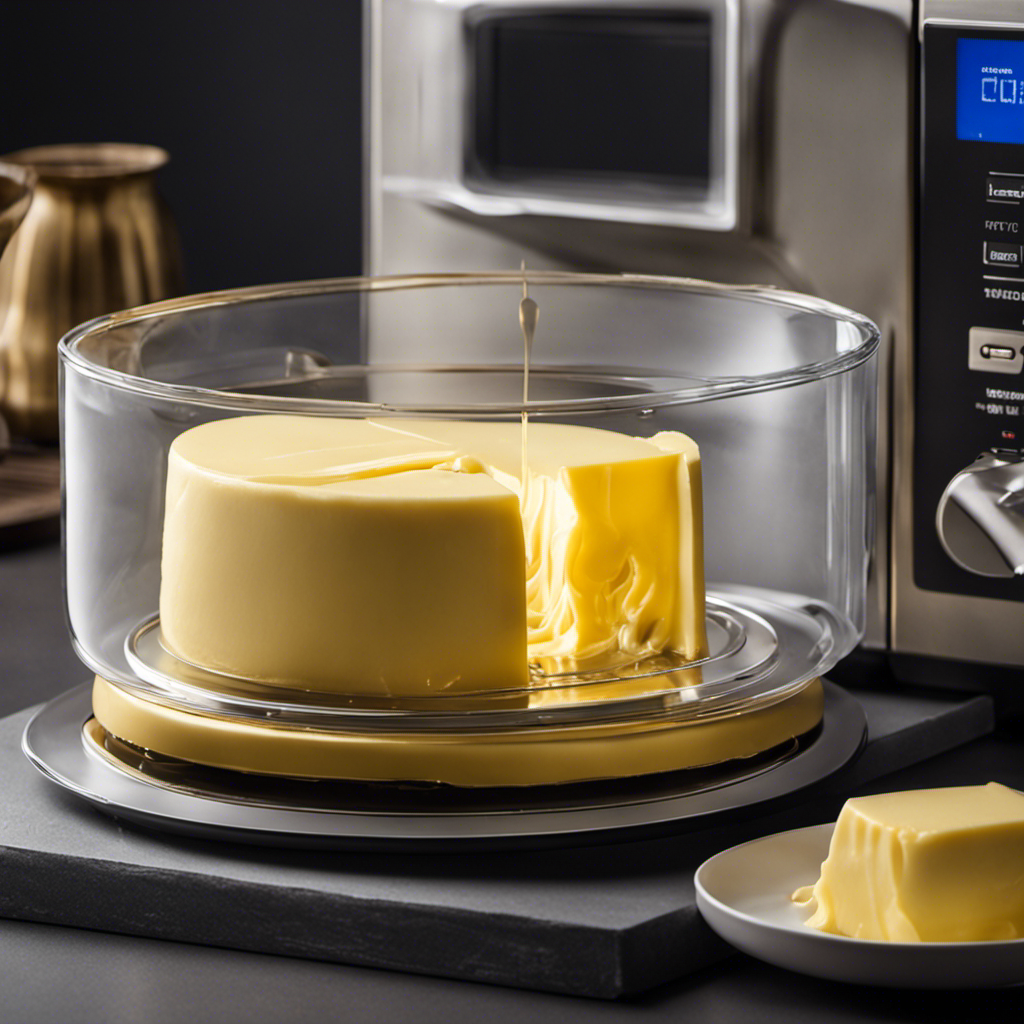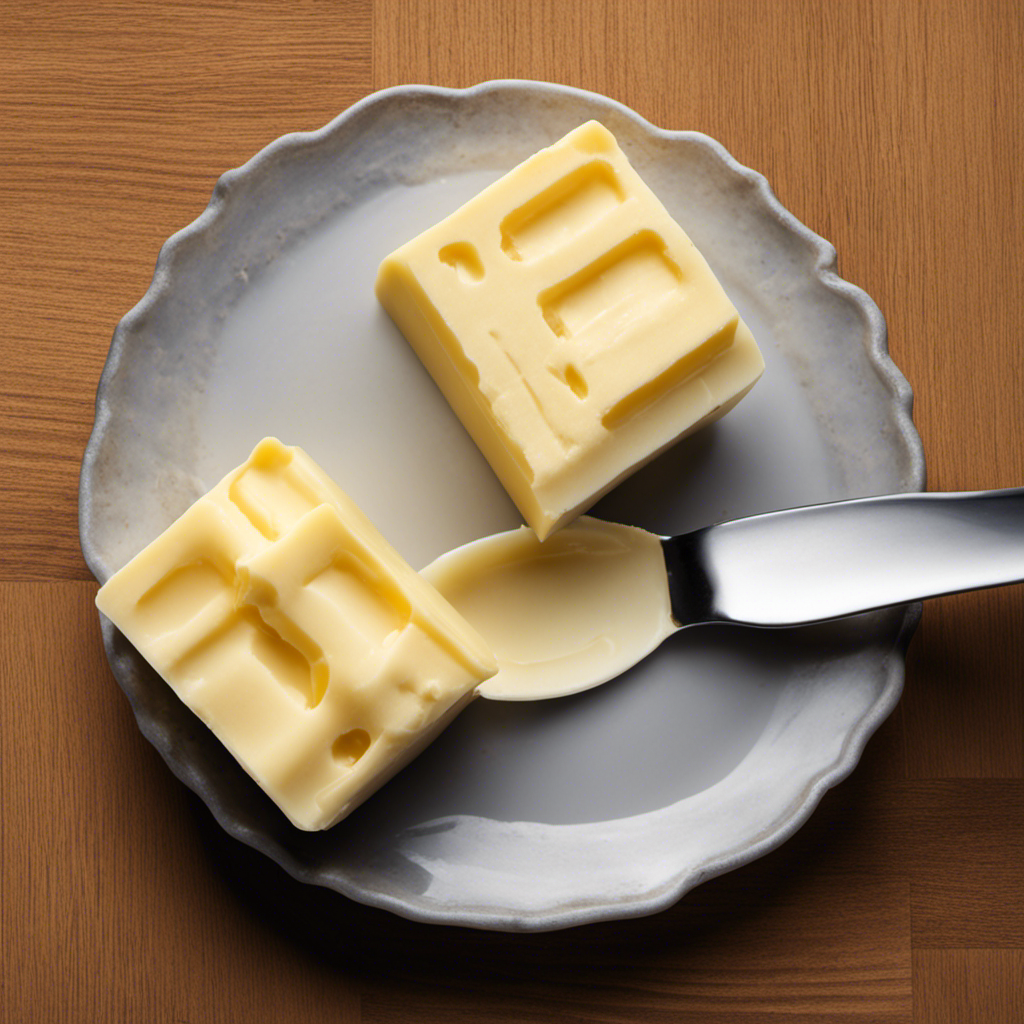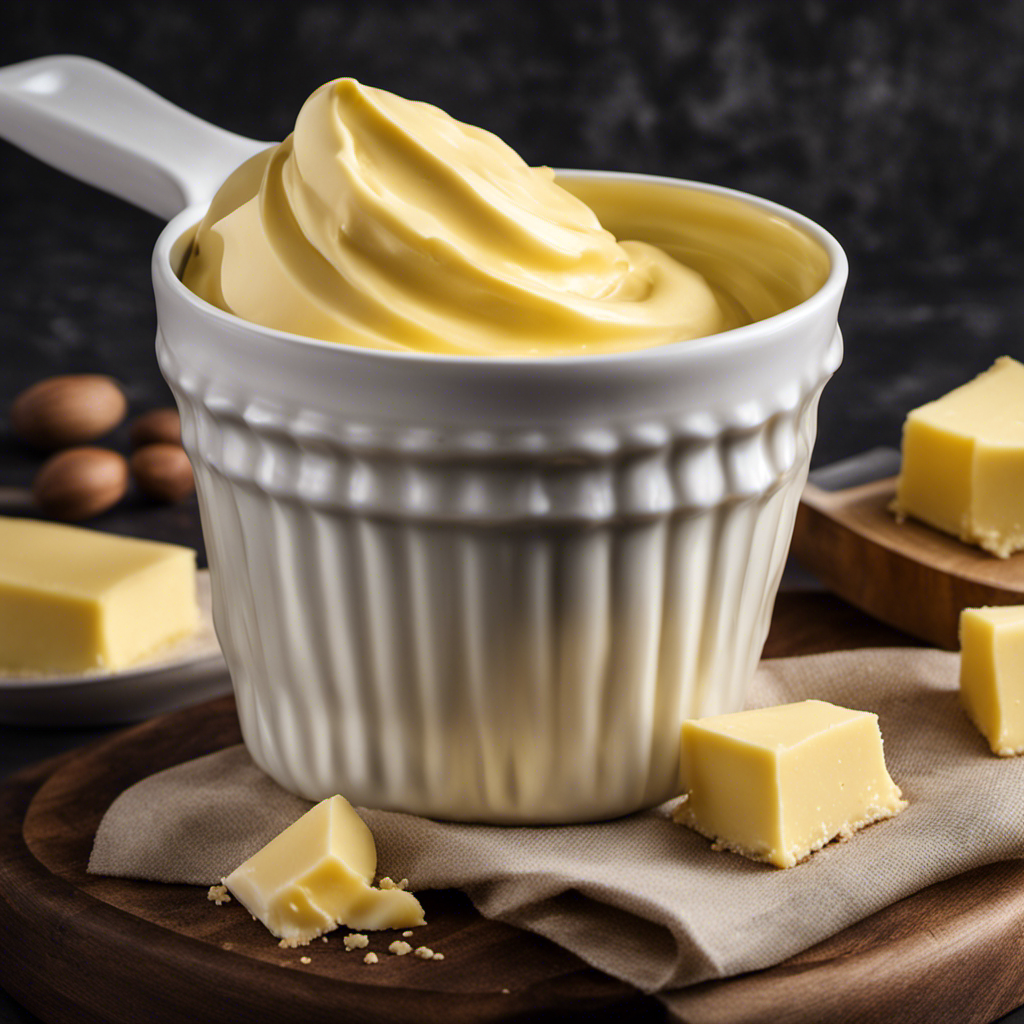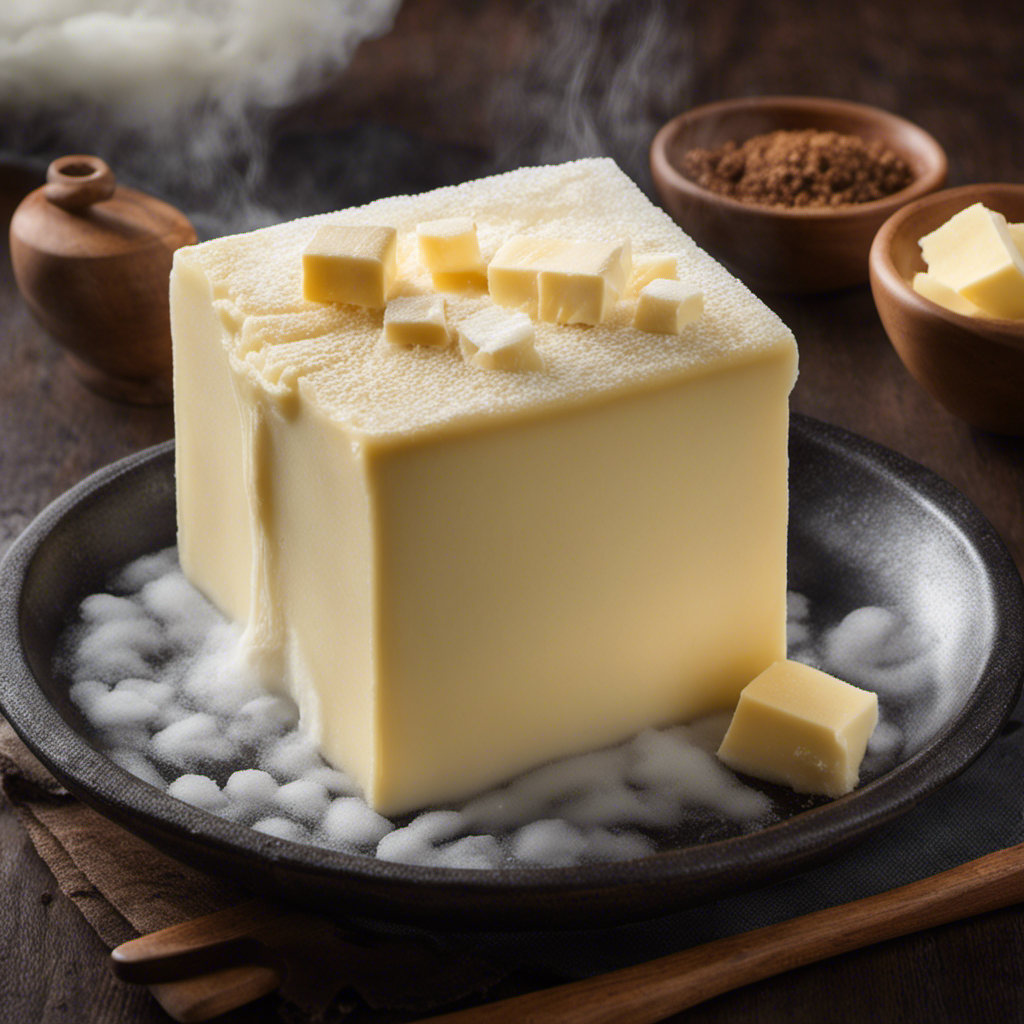As a baking enthusiast, I’ve discovered that accurate measurements are key to perfecting recipes. This is why I’m eager to offer my advice and methods for measuring butter with precision.
In this article, I’ll guide you through the different forms of butter, the tools you’ll need, and the step-by-step process of measuring butter using measuring spoons or a kitchen scale.
Get ready to elevate your baking game with perfectly measured butter every time.
Key Takeaways
- Accurate butter measurement is crucial for the outcome of recipes, as it directly affects texture, taste, and quality of baked goods.
- Butter can be measured in different forms such as sticks, cups, and grams, and knowing their measurement equivalents is essential for following recipes accurately.
- Measuring butter can be done using measuring spoons, a kitchen scale, the wrapping paper method, or by cutting it into cubes.
- Consistency in cube size is important for accurate measurement, as uniform cube sizes ensure each cube has the same weight and helps achieve precise measurements and reliable outcomes.
Why Is Accurate Butter Measurement Important
Accurate butter measurement is crucial in baking because it directly affects the outcome of your recipe. Using the correct amount of butter ensures that your baked goods will turn out exactly as intended. When it comes to butter, precision is key.
There are different techniques for measuring butter, such as using a kitchen scale or measuring spoons. Accuracy is important because too little or too much butter can alter the texture, taste, and overall quality of your baked goods. For instance, too much butter can make your cookies spread too thin, while too little can result in a dry and crumbly texture.
Different Forms of Butter and Their Measurement Equivalents
To accurately determine the equivalent measurements for different forms of butter, you’ll need to consult a reliable conversion chart.
Butter comes in various forms, including sticks, cups, and grams. Each form requires a specific measurement to ensure accurate results in your recipes.
One stick of butter is equal to 1/2 cup or 113 grams. This is important to know when a recipe calls for a specific quantity of butter in cups or grams. If you only have a stick of butter, you can easily convert it to the required measurement using the conversion chart.
Understanding the measurement equivalents for different forms of butter will help you follow recipes accurately and achieve the desired results in your baked goods.
Tools and Equipment Needed for Measuring Butter
When measuring butter, you’ll need a scale, measuring cups, and a butter dish. Measuring butter equivalents can be tricky, especially when dealing with different forms of butter. It’s important to know the conversion rates between solid butter and melted butter, as well as between sticks of butter and cups.
For example, 1 stick of butter is equivalent to 1/2 cup or 8 tablespoons. If a recipe calls for 1 cup of melted butter, you’ll need 2 sticks or 16 tablespoons.
To measure butter using a scale, simply place the butter dish on the scale and set it to zero. Then add the desired amount of butter until the scale reads the correct weight.
Measuring butter accurately is crucial for achieving the desired results in your recipes.
How to Measure Butter Using Measuring Spoons
Using measuring spoons is a convenient way to accurately portion out your butter. It ensures that you are using the right amount for your recipes, avoiding any potential issues with texture or taste. Here are some steps to measure butter using measuring spoons:
- Use a butter knife to cut the desired amount of butter from the stick.
- Level off the butter by scraping the knife across the top of the measuring spoon.
- Repeat this process until you have measured the required amount.
Measuring butter using measuring spoons is a common method because it is simple and readily available in most kitchens. However, there are alternative methods of measuring butter, such as using measuring cups or a kitchen scale.
Transitioning into the next section, let’s explore how to measure butter using a kitchen scale for even more precise measurements.
Measuring Butter Using a Kitchen Scale
If you have a kitchen scale, all you need to do is place the stick of butter on it and weigh it to get an accurate measurement. Measuring butter by weight is a precise way to ensure your recipes turn out perfectly.
Converting butter measurements can be tricky, especially when recipes call for specific amounts in grams or ounces. However, with a kitchen scale, you can easily convert these measurements. Simply place the stick of butter on the scale and adjust until it shows the desired weight.
If your recipe calls for a different amount of butter, you can easily calculate the conversion using simple math. For example, if your recipe calls for 1/2 cup of butter, which is equivalent to 8 tablespoons, you can weigh out 113 grams or 4 ounces on your kitchen scale.
How to Measure Butter Using the Wrapping Paper Method
To accurately measure butter using the wrapping paper method, simply place the stick on the paper and mark the desired amount. This method is great for those who don’t have a kitchen scale or prefer a more visual approach to measuring.
Here are some alternatives to measuring butter and a useful tip for using butter molds:
- Soften the butter and use measuring spoons to scoop out the desired amount.
- Use the measurements on the butter wrapper itself, which are usually marked in tablespoons or cups.
- Invest in butter molds that have markings for different measurements. Simply press the softened butter into the mold and use the marked lines for accurate measuring.
Measuring butter by cutting it into cubes is another popular method that provides precise measurements.
Measuring Butter by Cutting It Into Cubes
When it comes to measuring butter, using cubes can provide precise measurements. By cutting the butter into uniform cubes, you can easily measure the exact amount needed for your recipe.
This consistency in cube size ensures that your measurements are accurate and your baked goods turn out just right. Plus, using cubes makes it easier to incorporate the butter into your baking recipes, ensuring even distribution and a delicious end result.
Cubes for Precise Measurement
Using butter cubes for precise measurement ensures accuracy in recipes. The consistency in cubes allows for uniformity in measurement, resulting in consistent and reliable outcomes.
The benefits of cubed butter are numerous:
- Easy to measure: Cubes provide a convenient size that can be easily weighed or measured using kitchen scales or measuring cups.
- Quick to melt: The smaller size of the cubes allows for faster and more even melting, ensuring that the butter is incorporated smoothly into the recipe.
- Efficient mixing: Cubes of butter mix more evenly and quickly with other ingredients, resulting in a smoother batter or dough.
Consistency in cube size is essential for accurate measurement. By ensuring that each cube has the same dimensions, you can be confident that you are using the correct amount of butter in your recipe.
Consistency in Cube Size
When it comes to measuring butter accurately, consistency in cube size is crucial. Having uniform cube sizes ensures that each cube has the same weight, which leads to precise measurements in recipes.
It is important to understand the significance of accurate measurements in baking and cooking. Inconsistent cube sizes can result in variations in the amount of butter used, which can throw off the balance of ingredients and affect the texture and taste of the final dish.
To achieve cube size consistency, I recommend using a ruler or a butter cutter with marked measurements. By ensuring that each cube is the same size, you can be confident that your measurements will be accurate, resulting in delicious and perfectly balanced dishes.
Easier for Baking Recipes
To make baking recipes easier, it’s important to ensure consistency in cube size for ingredients like butter. When a recipe calls for a specific amount of butter, it’s essential to measure it accurately. However, if you don’t have the required amount of butter or prefer alternatives, there are ways to convert the measurements.
Here are some helpful tips:
-
Use measuring spoons: If a recipe calls for tablespoons of butter, you can easily measure it using spoons. One tablespoon is equal to 14 grams or approximately half an ounce.
-
Use a kitchen scale: If you have a kitchen scale, you can weigh the butter in grams or ounces according to the recipe’s requirements. This method ensures precise measurements.
-
Use pre-packaged butter sticks: Some butter brands have pre-packaged sticks with measurements marked on the wrapper. This makes it convenient to measure the required amount of butter.
Tips for Measuring Butter Accurately
One important tip for measuring butter accurately is to soften it before measuring. Softening the butter helps to ensure that you get the correct amount when measuring.
To measure butter equivalents, it is helpful to know that 1 stick of butter is equal to 1/2 cup or 8 tablespoons. This is important information to have because many baking recipes call for specific amounts of butter.
Precise measurements are crucial in baking as they can affect the texture and consistency of the final product. Too much or too little butter can throw off the balance of ingredients and result in a different outcome.
Converting Butter Measurements for Recipes
If you’re unsure how much butter to use in a recipe, it can be helpful to know that 1 stick of butter is equal to 1/2 cup or 8 tablespoons. Converting butter measurements accurately is crucial for the success of your recipes.
Here are a few tips to help you get it right:
- Use a kitchen scale: Weighing the butter ensures precise measurements, especially when dealing with larger quantities.
- Cut the butter into tablespoons: If your recipe calls for a specific number of tablespoons, it’s easier to measure by cutting the butter into tablespoon-sized slices.
- Softened or melted butter: If your recipe asks for softened or melted butter, measure it after it reaches the desired state.
Accurate measurements are essential to achieve consistent results in baking and cooking. Now that we know how to convert butter measurements correctly, let’s explore some common mistakes to avoid when measuring butter.
Common Mistakes to Avoid When Measuring Butter
When it comes to measuring butter, there are a couple of common mistakes that can easily be made.
One of these mistakes is over or under-measuring the butter. It’s important to follow the recipe’s measurement precisely to ensure the right balance of ingredients.
Additionally, another mistake is not using the correct type of butter, whether it’s softened or cold. The texture of the butter can greatly affect the outcome of the recipe, so it’s crucial to use the right kind as specified in the recipe.
Over or Under-Measuring
It’s important to avoid over or under-measuring butter to ensure accurate results in your recipes. When it comes to measuring butter, precision is key. Here are some things to keep in mind to avoid common mistakes:
-
Over Measuring: Adding too much butter can lead to greasy and heavy baked goods. To avoid this, always use a measuring spoon or knife to scrape off any excess butter from the measuring cup.
-
Under Measuring: Not using enough butter can result in dry and crumbly baked goods. Make sure to pack the butter firmly into the measuring cup, leveling it off with a straight edge for an accurate measurement.
-
Room Temperature Butter: Most recipes call for softened butter. To achieve the perfect consistency, let the butter sit at room temperature for about 30 minutes before measuring.
Softened Vs. Cold Butter
To achieve the perfect consistency in your recipes, make sure to use softened butter rather than cold butter. Softened butter is butter that has been left out at room temperature until it becomes easy to spread. It should be cool to the touch and pliable, but not melted.
Softened butter is essential in baking because it helps incorporate air into the batter, resulting in a lighter texture. On the other hand, cold butter is hard and difficult to mix. It doesn’t blend well with other ingredients and can lead to uneven distribution of fat, affecting the final texture of your baked goods.
Storing and Preserving Butter for Accurate Measurement
Storing butter properly ensures accurate measurement. To maintain butter freshness and prevent spoilage, follow these storing techniques:
-
Keep butter in its original packaging or wrap it tightly in wax paper or plastic wrap to protect it from absorbing other flavors in the fridge.
-
Store butter in the coldest part of your refrigerator, ideally at a temperature between 32°F and 40°F (0°C and 4°C).
-
If you prefer to keep butter at room temperature for easy spreading, use a butter dish with a lid or a butter crock that keeps it fresh for up to a week.
Frequently Asked Questions
Can I Use Margarine or Oil as a Substitute for Butter in Recipes?
Yes, you can use margarine or oil as a substitute for butter in recipes. Margarine can offer health benefits, while different types of oil can provide unique flavors and textures to your dishes.
How Do I Measure Melted Butter?
To measure melted butter, pour it into a liquid measuring cup and use the markings for ounces or milliliters. If you need to convert melted butter to solid form, simply refrigerate it until it solidifies.
Is It Necessary to Soften Butter Before Measuring It?
It’s necessary to soften butter before measuring it because it ensures accurate measurements. If you don’t have softened butter, you can use alternatives like margarine or oil in recipes, but be mindful of their different properties.
Can I Use a Regular Knife Instead of a Butter Knife to Measure Butter?
Sure, you can use a regular knife to measure butter. It’s important to remember that the measurements may not be as precise as using a butter knife, but it can still get the job done.
How Do I Measure Butter if the Packaging Does Not Have Measurements Indicated?
To measure butter without indicated packaging measurements, I recommend using a kitchen scale. Place a bowl on the scale, zero it out, and then add the desired amount of butter. Convert measurements using online resources if needed.
Conclusion
In conclusion, accurately measuring butter is crucial for achieving the perfect balance of flavors and textures in your culinary creations.
Whether you’re using sticks, tablespoons, or grams, having the right tools and techniques will ensure consistency in your recipes.
Remember to avoid common mistakes like softening butter too much or not using a level measurement.
With proper storage and preservation, you can always have butter on hand for accurate measurement.
So go ahead and whip up some delicious dishes with confidence, knowing that your butter measurements are spot on!









